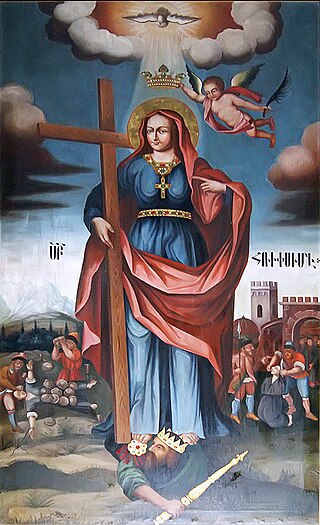
September 8 - Eastern Orthodox liturgical calendar - September 10

April 3 - Eastern Orthodox liturgical calendar - April 5

April 4 – Eastern Orthodox liturgical calendar – April 6

May 11 - Eastern Orthodox Church calendar - May 13

May 12 - Eastern Orthodox Church calendar - May 14

June 22 - Eastern Orthodox Church calendar - June 24

July 24 - Eastern Orthodox calendar - July 26

Pelagia, distinguished as Pelagia of Antioch, Pelagia the Penitent, and Pelagia the Harlot, was a Christian saint and hermit in the 4th or 5th century. Her feast day was celebrated on 8 October, originally in common with Saints Pelagia the Virgin and Pelagia of Tarsus. Pelagia died as a result of extreme asceticism, which had emaciated her to the point she could no longer be recognized. According to Orthodox tradition, she was buried in her cell. Upon the discovery that the renowned monk had been a woman, the holy fathers tried to keep it a secret, but the gossip spread and her relics drew pilgrims from as far off as Jericho and the Jordan valley.

August 17 - Eastern Orthodox liturgical calendar - August 19

January 17 - Eastern Orthodox liturgical calendar - January 19

January 23 - Eastern Orthodox liturgical calendar - January 25

Lydia of Thyatira is a woman mentioned in the New Testament who is regarded as the first documented convert to Christianity in Europe. Several Christian denominations have designated her a saint.

Euphrosyne of Alexandria, also called Euphrosynē, was a saint who disguised herself as a male to enter a monastery and live, for 38 years, as an ascetic. Her feast day is celebrated on September 25 by the Greek Orthodox Church, Episcopal Church, as well as Byzantine Rite Catholics, and January 16 by the Roman Catholic Church. Euphrosyne was born to a wealthy family in Alexandria; her father Paphnutius was a devout Christian and her mother died when Euphrosyne was twelve. When she was 18, her father wanted her to marry, so she escaped, disguised as a man, and entered the same monastery he often visited for spiritual counsel. She spent most of her years as a monk in seclusion because her beauty tempted the other monks. During the final year of her life, Euphrosyne became her father's spiritual director, comforting his grief over losing his only daughter. Eventually, she revealed her identity to him and they reconciled. After she died, he entered her monastery and became an ascetic himself, living in her cell until he died ten years later.

Eudokia was a Samarian woman who lived in Heliopolis of Phoenicia.

October 8 - Eastern Orthodox liturgical calendar - October 10

Gerasimus of the Jordan was a Christian saint, monk and abbot of the 5th century AD.

Hripsime, also called Rhipsime, Ripsime, Ripsima, Ripsimia, Ripsimus, Arbsima or Arsema was a martyr of Roman origin; she and her companions in martyrdom are venerated as some of the first Christian martyrs of Armenia.

Saint Paraskevi of Rome is venerated as a Christian martyr of the 2nd century. She was arrested and tortured under the reign of the Roman Emperor Antoninus Pius for her refusal to worship idols. Though he eventually released her after she performed a miracle that cured him of his blindness, she was arrested on multiple later occasions for her Christianity and was eventually beheaded by the Roman governor Tarasius.

March 15 - Eastern Orthodox liturgical calendar - March 17







